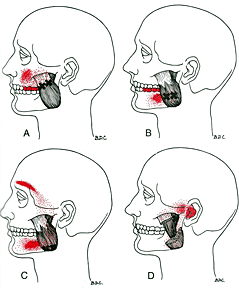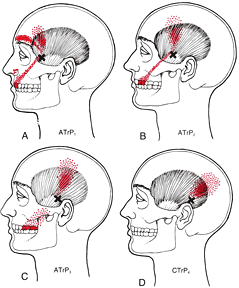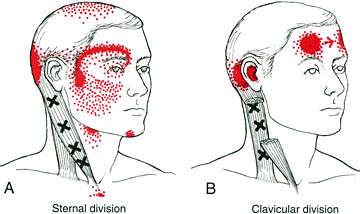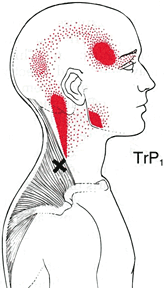Whether you accept it, avoid it or live somewhere in between, insurance coverage has become a defining issue for our profession. Patients increasingly expect to use their benefits, practitioners want to be compensated fairly for their time and expertise, and the system itself remains – at best – fragmented. The encouraging news is that coverage has expanded in meaningful ways. The challenging news is that reimbursement, across the board, remains inadequate.
Tackling TMJ
Researchers from Georgetown recently showed that acupuncture in rats reduces a protein that's associated with stress. While this gives hope to those for whom molecules make more sense than qi, it remains to be seen whether the findings can be replicated in humans. In the meantime, the Western-minded among us will appreciate that there's already a relatable framework for understanding how acupuncture relieves certain symptoms of stress. One of the most common, TMJ, responds very well to trigger-point acupuncture.
TMJ stands for temporomandibular joint, but "TMJ" has become a catch-all term for jaw pain that can radiate throughout the face, head and ear. (We'll refer to it that way in this article.) TMJ brings many people to acupuncture, as conventional medical therapies such as bite guards and medications usually offer temporary, if any, relief. It's especially common among people who also report high levels of stress.
TMJ often is a result of excessive muscular strain rather than an issue with the actual joint. (Handy tip: Think Muscles for Jaw Pain.) When we overwork our face and neck muscles, which we tend to when stressed—clenching or grinding our teeth, biting our nails, holding ourselves in tense postures—they can develop sensitive nodules that cause referred pain. These nodules, known as trigger points, can be released by inserting acupuncture needles directly into the affected muscle and/or its associated attachments.
Which Trigger Points Cause TMJ?
Trigger points ("X" on the images below) in several different face and neck muscles can cause jaw pain. Here are some of the most commonly afflicted.

Masseter. A trigger-point approach to treating TMJ usually involves a first look at the masseter. This is the big muscle that protrudes over the jawbone, commonly the area that people massage when describing jaw pain. Like other face and neck muscles, the masseter can develop trigger points from teeth clenching and grinding, excessive gum chewing or nail biting, and poor body mechanics. But this muscle more than others is affected by stress.
"The masseter muscles are among the first to contract in persons who are in a state of extreme emotional tension, intense determination, or desperation, and they remain contracted for abnormally long periods of time," says Janet Travell in her book "Myofascial Pain and Dysfunction: The Trigger Point Manual."
Trigger points in the masseter can refer pain to the cheeks, lower jaw, upper and lower molar teeth, up into the eyebrow, and deep into the ear and around the temporomandibular joint (see picture above). Since the main function of the masseter muscle is to elevate the mandible (the lower jawbone), cases where the person has a hard time opening his mouth usually indicate trigger points in the masseter. One-sided tinnitus can be another clue.

Temporalis
The pain patterns for trigger points in the temporalis muscle resemble those of the masseter (see picture at left). However, these patients tend to complain more explicitly of headaches, usually on the side of the head and along the eyebrow or behind the eye. The tooth pain associated with temporalis trigger points is felt in the upper teeth and not exclusively in the molars.
Medial and lateral pterygoid. These little muscles, when affected by trigger points, pack a powerful punch. They both refer pain directly to the temporomandibular joint region. Pain from medial pterygoid trigger points is concentrated directly in front of the ear and spreads downward along the jaw and upper outside of the neck. These trigger points also can cause throat pain and difficulty swallowing. Pain from lateral pterygoid trigger points, in addition to the temporomandibular joint area in front of the ear, radiates higher on the face, on the maxilla (upper jaw). Travell says trigger points in the lateral pterygoid "are the chief myofascial source of referred pain felt in the TMJ area."

SCM
The sternocleidomastoid, or SCM, has two divisions, both of which can cause TMJ symptoms when affected by trigger points (see picture at right). The sternal division primarily leads to pain above the eyebrow that spreads across the cheek and into the jaw. Pain may also appear at the back and top of the head. Trigger points in the clavicular division produce pain that's more concentrated in and around the ear, as well as frontal headaches.
Trapezius

Pain from trapezius trigger points spans from the arm to the head. One particular referral pattern, from trigger points in the upper part of the muscle, can mimic some symptoms of TMJ (see picture at left). In addition to lower jaw pain and temporal headaches, these trigger points can cause intense pain behind and below the ear that extends down to where the neck meets the shoulder. This is especially common in people who work at computers all day, as sustained elevation of the shoulders can produce and exacerbate trigger points in the trapezius.
Platysma
Considered one of the facial muscles, the platysma is a sheath-like muscle that extends from around the jaw down over the clavicle. Trigger points in the platysma cause a diffuse pricking pain over the lower jaw. The pain is felt more on the surface, at the skin level, rather than deep in the muscle.
Trigger Points Aren't the Whole Story
Needling trigger points is just one strategy for treating TMJ with acupuncture. Other more traditional styles can be equally effective, and acupuncturists who do trigger-point work usually come at it from an acupuncture perspective, which always considers the interplay between physical health and emotional/environmental factors.
Even Janet Travell, the biomedical physician credited with discovering trigger points, admits in her discussion of head and neck pain, "Isolated attention to individual TrPs [trigger points] early in treatment can be helpful to demonstrate to the patients and reassure them that their problem has a basic organic cause which they can do something about, but it will require a comprehensive approach to unravel all the intertwining components."
A trigger-point approach to TMJ may be a point of entry for those who struggle with acu-speak. Backed by the fundamental tenets of acupuncture, it's a comprehensive solution to addressing the many facets of this common condition.
*Trigger-point images from Myofascial Pain and Dysfunction: The Trigger Point Manual


